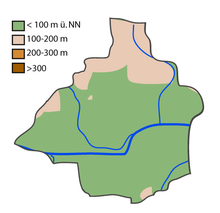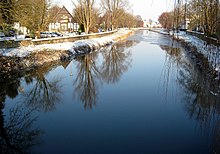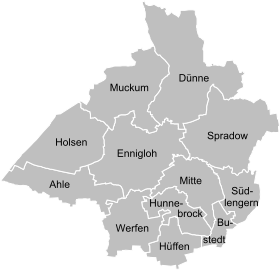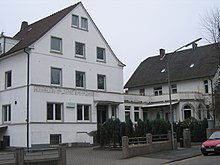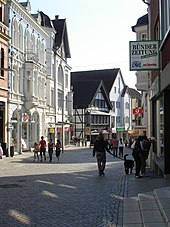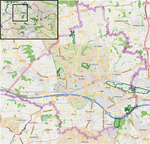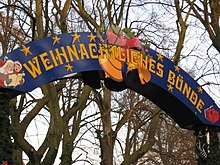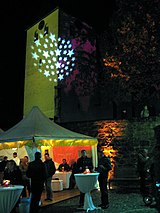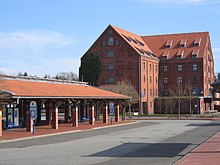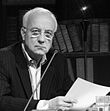Frets
| coat of arms | Germany map | |
|---|---|---|
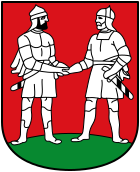
|
Coordinates: 52 ° 12 ' N , 8 ° 35' E |
|
| Basic data | ||
| State : | North Rhine-Westphalia | |
| Administrative region : | Detmold | |
| Circle : | Herford | |
| Height : | 75 m above sea level NHN | |
| Area : | 59.3 km 2 | |
| Residents: | 45,187 (Dec. 31, 2019) | |
| Population density : | 762 inhabitants per km 2 | |
| Postal code : | 32257 | |
| Area code : | 05223 | |
| License plate : | HF | |
| Community key : | 05 7 58 004 | |
| LOCODE : | DE BUE | |
| City structure: | 12 districts | |
City administration address : |
Bahnhofstrasse 13 + 15 32257 Bünde |
|
| Website : | ||
| Mayor : | Wolfgang Koch ( CDU ) | |
| Location of the city of Bünde in the Herford district | ||
Bünde [ ˈbʏndə ] ( Low German : Buine, Buüne ) is a medium- sized town belonging to the district in northeastern North Rhine-Westphalia about 20 km north of Bielefeld . With 47,387 inhabitants (as of February 4, 2019) it is the second largest city in the East Westphalian district of Herford ( administrative district Detmold ). Its territorial layout is the result of the local reform of 1969.
Bünde was first mentioned in writing as early as 853 as "Buginithi". Since the place was once the center of the European cigar industry , Bünde is still called the cigar city today .
geography
Geographical location
Bünde is located in the Ravensberger Mulde between the Teutoburg Forest and the Wiehen Mountains , mostly in the river basins of the Else . It has its lowest point at 59 m above sea level. NN in the east, where the Else leaves the urban area, its highest at 185 m above sea level. NN in the north, where the area slowly rises towards the Wiehengebirge.
The closest major cities are Bielefeld, 20 km south, and Osnabrück, 30 km west .
Neighboring communities
In the north, Bünde borders on the municipality of Hüllhorst in the neighboring district of Minden-Lübbecke . The city shares the eastern border with Kirchlengern along its entire length . To the south, the municipality of Hiddenhausen and the towns of Enger and Spenge meet Bünde. In the northwest and west, Bünde borders on Rödinghausen , and in the southwest on Melle , which already belongs to the neighboring state of Lower Saxony .
Waters
The city area is crossed in a west-east direction by the Else , one of the world's rare rivers that does not arise from a spring, but is created by bifurcation . It drains the entire site and ultimately flows into the North Sea via the Werre and Weser . Within the urban area, numerous smaller streams flow to it from the south and north. One example is the Gewinghauser Bach coming from the north , which crosses a meadow landscape in the Ennigloh- Gewinghausen district on its way to the Else . Further tributaries in the direction of flow are initially (coming from the north) the Ahler Bruchbach , which, starting in Rödinghausen, flows mainly through the district of Ahler Bruch and only flows into the Else in the Meller area; also the Darmühlenbach , also originating in Rödinghausen; then the Spradower Mühlenbach and finally the Eselsbach . The Werfener Bach also flows into the Else from the south .
geology
The area belongs to the Ravensberger Mulde , a slightly undulating, between 50 and 140 m above sea level. NN lying hill country . Numerous small valleys (so-called sieves ) often cut suddenly and deeply into the otherwise poorly coupled land. Geologically, it is essentially a matter of lias plates with loess overlay , which were transformed into hilly areas by the Pleistocene demolition . Under the loess cover, there are sometimes bedloads . Another legacy of the Pleistocene glaciers are the boulders that are often encountered .
The Elsetal and the lower course of the Werre further to the east form the low-lying glacial valley of the Else-Werre lowland, which runs in a west-east direction . With the 105 m above sea level. Doberg , high above sea level and therefore not actually a mountain in the geological sense , Bünde has one of the most extensive fossil deposits from the time of the Oligocene north of the Alps. The hill in the south of the city towers over its surroundings by about 30 m. It consists of the sediments of the Oligocene Sea and provides information about the marine fauna of that time. Outstanding finds, including the skeleton of a manatee that is millions of years old and a toothed whale, can be viewed in the Doberg Museum or, during its renovation, in the Striedieckschen Hof (Museum Island).

Bünde is medium to good, and in some eastern municipal locations it is even very suitable for the use of geothermal heat sources by means of a geothermal probe and heat recovery through heat pump heating (see the adjacent map).
Expansion and use of the urban area
Bünde has an area of 59.3 km². The north-south extension is 10.7 km, the east-west extension 11 km.
The urban area is heavily sprawled and has several settlement centers around the core city of Bünde, which were originally independent communities. In the south in particular, the urban area forms a continuous agglomeration with the cities of Herford and the municipality of Hiddenhausen . The unpopulated country has hardly any large forest areas. Due to its high fertility, the area is part of the old settlements and, like the rest of the Herford district , is used intensively in terms of landscape, while the meadows of the Else, which is often flooded in winter, are extensively farmed. In the fertile loess areas , mainly grain and maize, and increasingly also rapeseed, are cultivated. The following table shows the exact land use.
|
Area according to type of use |
Settlement and traffic areas |
Agricultural area |
Forest area |
other open spaces |
|---|---|---|---|---|
| Area in hectares | 2,228 | 3,370 | 254 | 72 |
| Share of total area | 37.6% | 56.8% | 4.3% | 1.2% |
City structure
Bünde consists of the core town of Bünde-Mitte and eleven districts that were independent municipalities or parts of the municipalities of the offices of Ennigloh, Kirchlengern and Herford-Hiddenhausen, which were dissolved at that time, until the regional reform on December 31, 1968 .
| District | Residents (Feb. 4, 2019) |
Area (km²) |
Density (Ew / km²) |
|---|---|---|---|
|
|
1.914 | 4.51 | 426 |
|
|
11,098 | 3.75 | 2,968 |
|
|
1,627 | 1.24 | 1,309 |
|
|
3,958 | 10.13 | 389 |
|
|
8,847 | 7.45 | 1,183 |
|
|
3,604 | 5.96 | 612 |
|
|
1.924 | 2.43 | 754 |
|
|
3,355 | 2.77 | 1,241 |
|
|
715 | 6.51 | 111 |
|
|
4,774 | 7.48 | 623 |
|
|
4,478 | 2.68 | 1,650 |
|
|
1,093 | 4.01 | 279 |
The district of Bünde-Mitte as the center of the city and the main settlement areas of the districts Ennigloh, Spradow, Südlengern, Bustedt, Hunnebrock and Hüffen have largely grown together today and together form the main part of the city of Bünde. The districts of Holsen and Ahle, located in the west of the city, have also mostly grown together, but like the districts of Muckum, Dünne and Werfen continue to form their own settlement centers outside the main part of the city. The development of the city of Bünde is also partially flowing into that of the neighboring communities Kirchlengern and Hiddenhausen .
climate
The predominant climate is the Atlantic maritime climate . Long-term average climatic data (1971–2000) for Herford , about 10 km from the air, is shown in the table below.
|
Monthly average temperatures and precipitation for Bünde (actually Herford)
Source: DWD
|
||||||||||||||||||||||||||||||||||||||||||||||||||||||||||||
In the period 1961–1990, the region had an average of 1473 hours of sunshine per year (observation station: Herford). The long-term average of the weather data for Bünde should hardly differ from the data given from Herford, as both cities are about the same height and their natural spatial location is very similar.
See also: Climate in Ostwestfalen-Lippe
history
Origins and becoming a city
The city coat of arms (two knights reaching out to each other) alludes to the Saxons Hengist and Horsa who, according to legend, made a covenant at this point in the 5th century to conquer England. In fact, the Saxon tribe of Engern lived in the Bünder Land at that time . However, it is rather unlikely that the name of the city can be traced back to this alliance . Rather, the name Bünde probably refers to a hill that was previously called Buhn (word related to stage ), from which the name Bünde developed by 1222. Even today, the elevated position of the old town center around the Laurentius Church compared to the Elseniederung is clearly visible.
On May 22, 853, Bünde was first mentioned as Buginithi in a deed of gift. In it, King Ludwig the German confirms that his father Ludwig the Pious had given the Bünde Church in the Diocese of Osnabrück to the Herford Abbey. The document itself no longer exists. There is still a copy from the 11th century. This makes Bünde one of the oldest settlements in the fertile Ravensberger Land . Thanks to its central location, Bünde already gained a certain importance in the Middle Ages. Church, market and jurisdiction attracted not only farms but also traders and craftsmen as well as day laborers and kötter . In the 11th century the parish of Bünde emerged from the village and 15 farmers. In 1152 the noblemen of Blankena, who exercised sovereignty over the area, were first mentioned in a document. Her castle, the Castrum Blankena , no longer preserved today , is believed to be west of Bünde-Mitte. After 1280 the trace of this noble family is lost.
Today's urban area has belonged to the Grafschaft Ravensberg since 1530 , with the exception of the districts Spradow and Dünne, which belonged to the Principality of Minden and the Principality of Minden . The bishop of Osnabrück and the noble lords of Lippe lost their jurisdiction. The city fell to Brandenburg-Prussia in 1614 via the county of Ravensberg . The Prussian king Friedrich Wilhelm I gave the place frets in 1719 the city rights - at first but not as a full city, but as a titular town . From 1807 to 1810, Bünde was part of the - de facto French - Kingdom of Westphalia and from 1811 to 1813 (officially until 1815) part of the French Empire in the Département de l'Ems-Supérieur (Upper Ems Department). Thin and Spradow remained part of the Kingdom of Westphalia. From 1816 to 1832 - again in Prussia - Bünde was the district town of the Bünde district , but still not a full town, so it was still administered according to a rural community code. In 1832 the Bünde district became part of the Herford district. In 1843 the city of Bünde, the communities Ahle, Dünne, Ennigloh, Holsen, Hunnebrock, Hüffen, Muckum, Spradow, Südlengern, Werfen and the Steinlake manor district merged to form the Bünde office. It was not until 1902 that Bünde became a full town when he left the Bünde office (from 1902: Ennigloh office).
Flax processing
From the 15th century to the 1830s, flax processing in the spinning and weaving trade was the main and secondary activity of many Bündner in Bünde, especially the poor heuerlings and Kötter in the surrounding districts, which formerly formed independent communities. The rural population suffered above all from the division of the farm, which meant that even in the fertile Ravensberger Land the farm was no longer large enough to feed their families. With the introduction of mechanical looms, this craft, often practiced at home, collapsed completely. In 1860, for example, the straw weaving company founded in 1853 finally had to close its doors. Many Bünder emigrated to America because of this and because of the bad harvests in the famine years 1845–1848. From 1850 to 1900, 1,083 citizens emigrated (partly illegally).
Industrialization and the tobacco industry from 1842
The Bünder Raum as part of the cultural landscape of the Ravensberger Land was intensely affected by industrialization in the 19th century . A special feature in this regard was its development into a center of the German tobacco industry , which made Bünde known as the cigar town. At the turn of the 19th and 20th centuries, more than 20 cigar factories were based in Bünde, and the majority of the cigars sold in Germany came from the cigar city. Other branches of business, such as printing, cardboard box and cigar box manufacturers, grew with the steady upward development of the cigar industry. Georg Meyer laid the foundation stone for this in 1842 in a specially purchased building at Eschstrasse 21. However, the real success story began above all with the business idea of Tönnies Wellensieks from Muckum, who learned to make cigars in Bremen and transported the “brown gold” to Bünde by hand and there he set up his first own business in his parents' house in Ennigloh in 1843. After just three years, he employed eight workers and relocated his company to Eschstrasse. In 1856 Wellensiek founded the company Steinmeister & Wellensiek together with August Steinmeister from Meschede . In 1849 there were already 18 tobacco processing companies in the Herford district . Often the cigars (especially in the rural surroundings of the city) were also rolled at home . With the construction of the Osnabrück-Löhne railway line in 1855, the transport of raw tobacco, which at that time came from the Netherlands , became even more efficient; This is why the cigar industry grew so rapidly that in 1862 3,000 people were already employed in Bünde and there were over 2,000 branches in the vicinity. In 1900 there were already 3,372 employees in 84 factories, although the city of Bünde only had around 4,800 inhabitants at that time.
It was only when the demand for cigars declined in the 1960s that the Bünder tobacco industry collapsed, not least because the manufacturers located here had not started producing the increasingly popular cigarettes in time. Another reason was that the factories in Graubünden had fallen behind the already highly industrialized foreign competition due to the ban on winding machines during the Nazi era .
Third Reich and World War II
After seizing power , the NSDAP received 53 percent of the votes in the Reichstag election in Bünde in March 1933 , and 44.4 percent in the Ennigloh office, which was then independent. In the local elections that followed , the National Socialists won an absolute majority and, as a result, held 10 of the 18 seats on the city council and occupied important official positions. Although they did not succeed in replacing the incumbent mayor, Moes was able to influence his political decisions through NSDAP representatives. The Jewish residents of the Bund were deported if they did not manage to escape in time. During the Second World War , hundreds of Italians, French, Poles, Russians and other prisoners of war had to do forced labor in Bünder companies, e.g. B. at Imperial.
In 1943 the Allies flew attacks on railway lines, which also killed civilians. During “ Big Week ” USAAF B-17 bombers attacked Bünde on February 22, 1944 as a “target of opportunity”. During the air raid with 32 machines, 140 high-explosive and 160 incendiary bombs were dropped. On April 2, 1945, parts of the 5th US Panzer Division reached the Herford district and also ended the National Socialist rule in Bünde. One day later, at noon, the city of Bünde and the Ennigloh office were handed over to the American troops. Bünde was not involved in direct combat operations on the ground, but British aircraft were shot down several times over his area.
After 1945
In the same year the British set up the Control Commission for Germany (CCG) for their occupation zone in Bünde . From 1957 to 1991 the Soviet military mission was also located here . Soviet soldiers lived on a hermetically sealed area, sometimes with their families. Their task was to obtain military information. Due to their diplomatic status , they were able to carry out this task within the British zone without risk and relatively unhindered. Subsequently, soldiers of the 1st Panzer Division of the British Armed Forces in Germany based in Herford will live there until 2015 . The old town of Bünde (Bünde-Mitte) was united by the regional reform on January 1, 1969 with the Ennigloh office and part of the Herford-Hiddenhausen office to form today's city. The formerly independent municipalities in the offices lost their independence. Since then there have been no further incorporations.
Population development
The following overview shows the population figures according to the respective territorial status, i. H. formerly for the municipalities of the Ennigloh office plus the residents of the core city of Bünde (see also footnotes at the end of the table).
|
|
1 To the district of Bünde belonged the city of Bünde and the communities Ahle, Dünne, Ennigloh, Holsen, Hüffen, Hunnebrock, Muckum, Spradow, Südlengern and Werfen as well as the manor district Steinlake. Before 1871, the number of inhabitants was determined according to inconsistent survey procedures. Data from 1871 onwards refer to the “local population”.
2 These are the combined numbers of inhabitants of the Ennigloh office and the city of Bünde. They come from updates of the statistical office of the NW or census results. Figures from 1925 onwards relate to the resident population .
3 The information relates to the areas that have belonged to the city of Bünde since January 1, 1970.
4 The information is an update of the statistical state office NW. The data from 1974 onwards relate to the resident population and since 1987 to the “population at the place of the main residence”.
Religions
Overview
Most of the residents in the Bünder Land are Protestant. However, there are also other churches and religious communities. Exact statistics are neither collected nor published. However, the religious affiliation of the Bünder students can be a clue. According to this, around 68 percent of them were Protestant, 10 percent Catholic and 7.3 percent Muslim in the 2002/2003 school year. The rest of the students were religious or non-denominational.
Evangelical congregations
There are five Evangelical Lutheran parishes in Bünde (before 2007 seven) with their own churches, including the two Evangelical churches in the historical center of Bündes, the Laurentius Church and the Paulus Church. There are parishes in the districts of Dünne, Ennigloh, Holsen-Ahle, Hunnebrock-Hüffen-Werfen and Spradow, Südlengern (Heide district) and Bünde (center). Südlengern and Bünde merged at the end of 2007 to form the Lydia parish of Bünde. At the end of 2009, Ennigloh and Holsen-Ahle merged to form the Philippus parish.
Closely associated with the most evangelical churches are the local branches of the YMCA , in frets Center, Ennigloh, Muckum, Holsen Broach, Thin and Hunnebrock-Hüffen-throwing youth group - and offers other youth work. The local associations in the municipality of Kirchlengern and Rödinghausen also belong to the area of the YMCA district association of Bünde.
There is also an Evangelical City Mission, an Evangelical Free Church Community ( Baptists ) and a Mennonite Congregation in the Ennigloh district.
Catholic community
The Catholics in societies had for the first time since the 1864 Reformation the possibility of a re- Mass to celebrate. After the Second World War , the number of parishioners increased by leaps and bounds due to the influx of expellees (e.g. from predominantly Catholic Silesia).
In the church hierarchy , the Catholics of the parish St. Josef in Bünde-Mitte belong to the deanery of Herford-Minden in the Archdiocese of Paderborn .
In the parish of St. Michael in Bünde- Holsen , the Paderborn auxiliary bishop Matthias König was active as parish pastor and pastor .
Other Christian communities and special communities that emerged from Christianity
There are three congregations of Jehovah's Witnesses in Bünde that jointly use the community hall ("Kingdom Hall") in the Dünne district, a New Apostolic church that belongs to the Osnabrück district and a church of God in Ahle.
Muslim community
In the Ennigloh district (Amtshausstraße) there is a mosque that is located in a building that was previously used for other purposes. The mosque is operated by the Association of Turkish Workers, which is part of the DITIB association . There is also an Alevi congregation, whose headquarters are now on the first floor of the City Passage in the city center after the move from Spradow to Bünde-Mitte. The Alevi community in Bünde belongs to the umbrella organization Alevi Congregation Germany with its seat in Cologne.
Former Jewish community
In 1814 a Jewish community was formed in Bünde , which initially consisted of only five families. A synagogue was built in 1815 and the Bünde synagogue district was founded in 1856 . Between 1933 and 1939 the number of members fell from 66 to 28. The remaining parishioners were deported or had to flee during World War II. The church no longer exists. She is remembered by a plaque in Eschstrasse. Stumbling blocks also mark the former residence of deported or expelled Jewish citizens .
politics
Bünde has the status of a middle district city . It belongs to the Herford district . The county seat is Herford . Since 1999, the citizens have been electing the mayor in a direct election. Another body to be elected is the city council, which meets in the town hall in the Mitte district.
MPs
Angela Lück ( SPD ) represents the city of Bünde in the state parliament of North Rhine-Westphalia .
Stefan Schwartze ( SPD ) represents the city in the German Bundestag .
City council
|
Allocation of seats in the
Bünder City Council 2014 A total of 40 seats
|
The city council of Bünde currently consists of 40 members. In addition, the mayor is the council chairman. The following table shows the composition of the council and local election results since 1975:
| City Council of Bünde: Share of voters and local councils since 1975 | |||||||||||||||||||||||||||||
|---|---|---|---|---|---|---|---|---|---|---|---|---|---|---|---|---|---|---|---|---|---|---|---|---|---|---|---|---|---|
| total | electoral participation |
||||||||||||||||||||||||||||
| Electoral term | % |
|
% |
|
% |
|
% |
|
% |
|
% |
|
% |
|
% |
|
% |
|
% | ||||||||||
| 1975-1979 | 40.01 | 18th | 47.10 | 21st | 12.90 | 6th | 100 | 45 | 88.04 | ||||||||||||||||||||
| 1979-1984 | 36.15 | 16 | 47.81 | 22nd | 9.53 | 4th | 6.51 | 3 | 100 | 45 | 76.37 | ||||||||||||||||||
| 1984-1989 | 33.12 | 16 | 48.25 | 23 | 7.45 | 3 | 6.27 | 3 | 4.91 | 0 | 100 | 45 | 69.74 | ||||||||||||||||
| 1989-1994 | 34.06 | 16 | 48.91 | 22nd | 9.12 | 4th | 7.91 | 3 | 100 | 45 | 66.01 | ||||||||||||||||||
| 1994-1999 | 39.25 | 19th | 45.70 | 22nd | 9.00 | 4th | 4.50 | 0 | 1.55 | 0 | 100 | 45 | 82.23 | ||||||||||||||||
| 1999-2004 | 46.74 | 21st | 39.89 | 17th | 5.92 | 3 | 7.45 | 3 | 100 | 44 | 56.37 | ||||||||||||||||||
| 2004-2009 | 42.54 | 19th | 35.45 | 15th | 8.67 | 4th | 6.89 | 3 | 6.45 | 3 | 100 | 44 | 53.04 | ||||||||||||||||
| 2009-2014 | 34.97 | 15th | 32.26 | 14th | 13.69 | 6th | 10.51 | 5 | 4.01 | 2 | 5.56 | 2 | 100 | 44 | 50.66 | ||||||||||||||
| 2014-2019 | 38.3 | 15th | 37.8 | 15th | 12.4 | 5 | 5.0 | 2 | 6.5 | 3 | 100 | 40 | 49.9 | ||||||||||||||||
|
Percentages rounded. Sources: State database NRW; State Office for Information and Technology NRW ; Municipal data center Minden-Ravensberg / Lippe
1 Independent constituency of Bünde; 2 alternative list; 3 citizen union leagues |
|||||||||||||||||||||||||||||
mayor
From 1999 to 2009 Anett Kleine-Döpke-Güse (CDU) was mayor of the city of Bünde. She was elected in 1999 with 51.2 percent of the vote in the second ballot and re-elected in 2004 with 54.2 percent in the first ballot. In the mayoral election on August 30, 2009, Kleine-Döpke-Güse decided not to run again and Wolfgang Koch (CDU) was elected as the new mayor with 34.71 percent of the vote. He took office in October 2009 and was re-elected in the 2014 mayoral election with 52.5%. He had to go to the runoff election.
The previous mayors of Bündes since 1969 were:
| mayor | Political party | Term of office | Remarks |
|---|---|---|---|
| Werner Herbrechtsmeier | until 1969 or until the regional reform | unsalaried | |
| Siegfried Moning | SPD | 1969-1975 | unsalaried |
| Wolfgang Fuchs | CDU | 1975-1979 | unsalaried |
| Herbert Voss | SPD | 1979-1990 | unsalaried |
| Siegfried Hagemann | SPD | 1990-1997 | unsalaried |
| Gerhard Thees | SPD | 1997-1999 | full-time, previously city director . |
| Anett Kleine-Döpke-Güse | CDU | 1999-2009 | full-time |
| Wolfgang Koch | CDU | from October 2009 | full-time |
Town twinning
-
 Leisnig , District of Central Saxony , Saxony .
Leisnig , District of Central Saxony , Saxony .
The partnership with the Saxon town of Leisnig with around 9,000 inhabitants has existed since 1990. During the severe floods in East Germany in 2002, the town of Bünde supported its twin town with donations and the dispatch of disaster relief workers. -
 Jakobstad / Pietarsaari , Finland .
Jakobstad / Pietarsaari , Finland .
The Finnish city of Jakobstad (Finnish: Pietarsaari) has been a twin town since 1968. Since then, many students from both cities have got to know their respective twin cities through student exchanges. In Jakobstad, too, the tobacco industry was dominant in earlier times. Over 20,000 people currently live there.
Coat of arms, flag and banner
| Banner, coat of arms and flag | |

|

|

|
|
The city coat of arms shows two knights reaching out and armor and in full armor on a red background. In the certificate of approval or the certificate of confirmation of the coat of arms of the district president in Detmold from April 28, 1972, the blazon reads : "In red on green ground, two silver (white) armed men facing each other, shaking hands." The coat of arms dates from 1892 and was first approved by the Prussian authorities in 1909. The motif alludes to the Saxons Hengist and Horsa , who, according to legend, made an alliance at this point in the 5th century to conquer England. The area around Bünde was actually settled by the Saxon Engern in the early Middle Ages . However, whether Hengist and Horsa, whose existence has not been clearly proven, can actually be associated with frets is controversial. Based on the city name Bünde, it was etymologically incorrect (see above ) to conclude that the coat of arms shows the conclusion of a covenant. Since the " Wittekindkreis " Herford heraldically emphasizes the Saxon ancestors of the region, the choice of Hengist and Horsas as the heraldic figures of the Bünder fit well into the heraldic tradition of the region (see also Westphalia horse ).
At the same time as the coat of arms, a flag and a banner were also awarded in 1972. These are divided or split by green, white and green in a ratio of 1: 2: 1. The coat of arms is on the white stripe; the flag moved towards the leech, the banner in the upper third.
See also: List of coats of arms in the Herford district and list of flags in the Herford district
Referendums
On August 27, 2006 was the first time frets referendum conducted. He dealt with the question of whether the Eschstrasse pedestrian zone should be extensively renovated. While the city council advocated this in order to maintain the attractiveness of Bündes as a shopping city, the initiators of the referendum turned against a feared “luxury renovation”. The required quorum was not achieved in the vote , so the redesign of the street began in 2007 and was completed in 2008.
education
As a middle center, Bünde has several secondary schools, which also serve the students of the neighboring communities. These include above all the two grammar schools , the grammar school on the market and the Freiherr-vom-Stein grammar school , which were formerly the girls 'and boys' grammar school. In addition, Bünde has ten primary schools , a special school , a secondary school , a comprehensive school , two secondary schools (Bünde-Mitte and Bünde-Nord), a vocational school (Erich-Gutenberg-Berufskolleg), a master school (non-profit educational center for professional development) and a music school .
The school center north in Ennigloh brings together the Freiherr-vom-Stein-Gymnasium, the Realschule Nord and the Erich-Kästner-Gesamtschule. In 2016, around 6,900 pupils attended general education schools in Graubünden, 1624 of them primary schools, 2118 grammar schools, 1192 secondary schools and another 1,585 comprehensive schools. 1561 students attended the vocational colleges.
The Bünder Stadtbibliothek, which was located in the Rahningschen Hof (see above) for many years , has since moved and is now housed in the former branch of the Federal Central Bank .
Culture
Theater and cinema
Bünde does not have its own theater ensemble or a theater building in the strict sense. The Bünder cultural offers, u. a. the theater and music subscription take place (next to the Universum, Kulturforum, Dammhaus etc.) in the town hall ( called "Stadtgarten" by the citizens of Graubünden ). The subscription, designed, organized and carried out by StadtKultur GbR , includes 10 events per season from the following categories: theater (classical, crime, drama, comedy, new theater, etc.) classical concerts, musicals, shows, ballet, dance theater, etc. a. The cultural season begins in October and ends in May. In addition, StadtKultur u. a. a children's theater and currently an a cappella series . With the help of an online advance booking system specially designed and introduced for Bünde (and the region), the program can be viewed and tickets for the individual events in z. Z. 15 advance booking offices or to purchase directly from home.
Cabaret, cabaret, comedy, concerts, children's cinema program (Fri and Sun from 3 p.m.), arthouse cinema (regularly once a month for three days) and project work take place in the Universum culture and event center , a theater in the district built in 1924 Bünde-Ennigloh. After a long vacancy - the demolition of the historic building was planned at the end of the nineties - it was saved from the wrecking ball through the strong commitment of a citizens' initiative, has since been extensively renovated and in 2001 took over the gaming operations as an event center and cinema under the care of a development association (for organization and Implementation: establishment of an operating company). Since then, around 90 live cultural events have taken place independently in the Universum and in the Stadtgarten in cooperation with StadtKultur GbR.
The Bünder Lichtspiele (Büli) show a pure cinema program in two halls.
Museums
The Bünde Museum is centrally located on the so-called Museum Island on Fünfhausenstrasse . It includes the Striedieckschen Hof , the Spieker and the Dammhaus , which are among the oldest buildings in the Bund, as well as a new building for the geological department. The museum is divided into a total of three areas: The German Tobacco and Cigar Museum has been providing vivid information about the unique history of tobacco processing in the Bünde area since 1937. It can u. a. historical tobacco pipes from all over the world, the largest smokable pipe in the world with a length of over 3.5 meters and the largest smokable cigar over 1 meter long can be visited. Immediately after Gerhard Schröder took office as Prime Minister of Lower Saxony in 1990 , he therefore sent the German Tobacco Museum an autograph card and a Cohiba .
In the Dobergmuseum - Geological Museum Ostwestfalen-Lippe there are numerous fossil finds from nearby Doberg (see above under "Geology"), but also fossils from the near and far surroundings of Bünde, in particular from the Wiehen Mountains and the Herford Lias basin . The Kreisheimatmuseum granted with a large peasant furniture exhibition insight into rural work and everyday life, which was closely linked to the flax processing.
art
music
Church music in Bünde is shaped by choirs in all districts. The Bünder Kantorei and the Arche Choir set the tone. The Bünder Kantorei has dedicated itself to classical, the Arche Choir to modern church music. In addition to the musical design of church services, there are numerous concerts by both choirs. With the participation of professional opera singers and orchestral musicians, the Kantorei performs works such as the St. Matthew Passion (Bach), the Christmas Oratorio (Bach) or the Carmina Burana (Orff). Another choir is the shanty choir of the Bünder Marinekameradschaft.
The careers of pop singer Gunter Gabriel , pop singer CC Catch and pop bard Maximilian Hecker also began in Bünde .
Visual arts
Since November 2012, more than 20 artists have been active in the “ KunstKarree ”. In addition to regular meetings, individual and group exhibitions take place both in Bünde and in the surrounding area. Charitable campaigns (e.g. for the benefit of the child protection association) were carried out several times. For the most part, two-dimensional works are made as drawings or painted pictures in watercolor, acrylic or oil.
Sports
There are almost 50 sports clubs in Bünde, in which around a third of all Graubünden members are active. The largest sports facilities are the Erich Martens Stadium and the Siegfred Moning Sports Hall (both in the Ennigloh district).
Bünde is home to the Bünder SV football club , whose first team currently plays in the district A league. The top division (3rd division) has so far been reached. In addition, many of the individual districts have their own football clubs, e.g. B. TuS Hunnebrock , FC Muckum 1946 , VfL Holsen currently top-playing team (national league), SV Schwarz-Weiß Ahle , or SG Grün-Weiß Bustedt 1945 . SG GW Bustedt also competes in the youth sector. In handball, the SG Bünde-Dünne and the HSG TuS / EK Spradow play in the state league in the 2012/2013 season. The Bünder Turnverein Westfalia has approx. 4000 members and its departments cover numerous sports. Another gymnastics club is the Ennigloh gymnastics community from 1887 . The largest athletics club is the SG Bünde / Ahle- Löhne . In cycling, the cycling club RC Olympia holds a cycling race once a year in Ennigloh at the Erich Gutenberg vocational college . The Bünde Berserker and the women's team Banshees play baseball in the Bismarck Ballpark and compete in the baseball regional league and association league. Swimming is widespread in Bünde. The two swimming clubs (TGE Ennigloh and DLRG Bünde) provide more than 500 active swimming athletes. The swimming department of the Turngemeinde Ennigloh (TGE) mainly offers competitive swimming according to the rules of the German Swimming Association. The DLRG Bünde is more oriented towards popular sport and offers, among other things, lifeguards and (equipment) diving. The Aero-Club Bünde, founded in 1951, has been operating sports aviation from the airfield in neighboring Melle since 1970. With currently around 100 members, currently 3 powered aircraft and 6 gliders, the association has set itself the task of training flight enthusiasts in particular. The Freiherr-vom-Stein-Gymnasium is known for its athletics department.
Swimming pools
There are public swimming pools at Steinmeisterpark in Bünde-Mitte (outdoor pool) and the Bünder Welle in Ennigloh (indoor pool).
The outdoor pool was built in 1937 and renovated in 1994. In 2008 the 10 m diving platform in the outdoor pool was renovated. At the beginning of 2020, the outdoor pool was demolished and replaced by a new building.
The Bünder Welle indoor pool was rebuilt from 2004 to 2006 and a second 25 m sports pool was added. At the same time, the old Ennigloh outdoor pool was demolished. With this expansion, the indoor swimming pool has two separate 25 m swimming pools. As a result, the indoor pool was given a clear emphasis on school and swimming sports and, with this orientation, is certainly a special feature in today's pool landscape.
Buildings
From the post-war period up to the 1980s, historic buildings often had to make way for new buildings. The town hall and the department store on Museum Square can be named as examples. For its construction, one of the city's historic half-timbered districts, “Die Ort”, was demolished. Nevertheless, Bünde still has some remarkable buildings to offer.
Monuments
The monument to the "cigar pioneers" Steinmeister & Wellensiek shows "Töns" Wellensiek with the handcart that is said to have brought tobacco from Bremen and his business partner Friedrich August Steinmeister .
The war memorial for those who died in the Wars of Unification at the Laurentius Church with the restored statue of Germania commemorates the victory of the Prussians over the French army on September 1, 1871. The statue of Germania, the model of which was then still young Gustav Eberlein in the sculptor's workshop Johannes Janda had created, was for approx. 300 thalers as catalog goods from the Berlin foundry A. Castner, vorm. M. Geiss was sold to Bünde. The Herford stonemason Rosenfeld supplied the base made of light sandstone. The laying of the foundation stone was on July 25, 1874; The monument was ceremoniously unveiled on Sedan Day in 1874.
Churches and half-timbered houses
The historical center of Bündes is located around today's Evangelical Lutheran Church of St. Laurentius , one of the oldest churches in Westphalia . It was first mentioned in a document in 853 during the time of Ludwig the German (around 806-876). After several building and renovation measures, the late Romanesque Kreuzsaal, which is still essentially preserved today, was built in the 13th century. The west tower dates much earlier. The church has been a listed building since 1985.
The rectory from 1822 on Kirchplatz was extensively restored at the beginning of the 21st century. On the town hall forecourt are the Rahning court from 1677 (burned down in 1748, rebuilt in 1749) and the Dahlkötter house from 1555 (today's building built around 1800), in which the registry office is located and in whose cellar the police station's prison was previously housed.
The house Rahning is a hall house based on the principle of the 4- frame half-timbered house , as they are very similar to be found in the villages around Bünde, z. B. the Hellmann farm in Holsen. Further examples are the three-aisled four-column house "Hurlbrinksches Haus" (first mentioned in 1688), the two-column house "Dammhaus" from 1595 and the "Striediecksche Hof" from 1830, which together form the complex of the local history museum.
Via the historic street Auf'm Tie and Eschstraße , Bündes pedestrian zone, you get to the second Bünder Stadtkirche, the Pauluskirche (built 1869–1873). The three-aisled hall church built from Weser sandstone in the neo-Gothic style was designed as a preaching church. H. the pulpit stands in the midst of the listening community.
Villas of the cigar manufacturers
Numerous villas from the heyday of the Bünder tobacco industry can be found all over the inner city area. B. in Bahnhofstrasse, Eschstrasse and Hindenburgstrasse. Worth seeing are u. a. the Villa Rehling of the cigar manufacturer Carl-Heinrich Rehling in the Hindenburgstrasse 3 (1893/1904) or the neo-baroque Villa André (Hindenburgstrasse 11) of the cigar manufacturer Georg (1891). After the war, Villa André was used as a kindergarten for the children of the British occupation troops in Bünde. Further examples are the Steinmeister villas (Eschstrasse 43 and 45) from 1843/1900, the Wellensiek residential building at Eschstrasse 35 from the beginning of the 19th century.
Tobacco store
The tobacco store near the train station also belongs to the same historical epoch. Erected in red brick, it is somewhat reminiscent of Hanseatic warehouses. It is the only remaining tobacco store in Westphalia that still serves its original purpose. The red brick building was built in 1896 by the Bremen cigar company Leopold, Engelhard & Biermann. In 1930, the tobacco store was initially obsolete and was sold to the Reichsbahn. Today it is used again as a tobacco warehouse for the André cigar factory. Machines from the German Tobacco and Cigar Museum are also stored there.
Other structures
In the Ennigloh district stands the former Ennigloh Amtshaus, which was built in Art Nouveau style in 1902 with a renaissance-like south gable, when the Ennigloh Amt had to be founded after the city of Bünde left the Bünde office. Today the music school is housed there.
The Universum , built in 1924, is one of the oldest cinemas in Germany and, after its closure in 1980, has since been transformed into a successful event center for cabaret, comedy and concerts.
According to the company, the oldest discotheque in Germany, the "Wilhelmshöhe", is located in Bünde . It was founded in 1961 and is still owned by the family of the founders today.
Between the two world wars, the low-cost thin clay bread construction was developed in the Dünne district ; a construction method in which undried mud bricks were placed on top of each other without using mortar. This partially unplastered construction also spread within East Westphalia because of the pleasant living climate; Between 1927 and 1933 around 300 such mud houses were built .
Farmhouses in the districts
Historic half-timbered houses worth seeing have been preserved in many districts, for example in Ennigloh Hof Claus (1740s), in Hunnebrock Hof Wittemeier (around 1840); in Südlengern the Tiemeyer court (1605) and the Wortmann court in Werfen (dated 1855, but probably end of the 18th century). One of the most splendid carved arches is the one at “Webers Kotten”, also in Werfen (1821).
Parks
The largest park is the centrally located Steinmeisterpark (between Bismarckstraße, Goetheplatz and Nordring), which was created around a small artificial lake. In the Ennigloh district there is the Dustholz , a small wood that can be used by residents in the vicinity for walks and in which there is a mini golf course and a fish pond. There is a spa park in the former Bauernbad Randringhausen.
Natural monuments and nature reserves
With the Doberg , Bünde has one of the most extensive fossil deposits from the time of the Oligocene north of the Alps. The hill in the south of the city towers over its surroundings by about 30 m. It consists of the sediments of the Oligocene Sea and provides information about the marine fauna of that time. Outstanding finds can be viewed in the Doberg Museum in the city of Bünde.
Other nature reserves in Bünde are the Bustedter Holz , the Elseauen , the Gewinghauser Bachtal , the Habighorster Wiesental and the Ennigloh brickworks . A total of around 175.2 hectares, or 2.95% of the urban area, are under nature protection.
Regular events
Fairs
Annual highlights are the Spring Festival and the onion market (on the weekend of the last Sunday in September) with plenty of Federweisser and onion tarts . Both events take place in the city center. While the city center is decorated with numerous flowers and plants by local gardeners for the Spring Festival, the onion market focuses on rides and similar fairground attractions. In December there is a small Christmas market around the Laurentiuskirche .
Other Events
- Bünder Schützenfest: The Bünder Schützenfest takes place every year. a. with the “Big Zapfenstreich” in the city hall, the city garden and in the center of Grisons.
- The Bünder Missionsfest has been held annually in Bünde since 1845 and has set itself the goal of spreading Christianity around the world. In the past it was of supraregional importance for the entire Minden-Ravensberger Land, today it only takes place on a small scale. The mission festival in Bünde emerged from the spiritual awakening movement that began around 1830. Revival preachers like Volkening called the mission festivals into being, because mission was seen as the main task of the church
- 1,000 bikes Bünde (Volksradfahren): Bünde has been recognized as a bike-friendly city by the working group for bicycle-friendly cities and municipalities in North Rhine-Westphalia . Once a year, a popular cycling event organized by the RC Olympia Bünde in cooperation with the city with hundreds of participants takes place in the Bünder city area.
- Onion Market: Annual fair in the city center with rides and dining areas.
- Cycle race Rund in Bünde, organized by RC Olympia Bünde, usually takes place in June at the Erich Gutenberg Vocational College.
- Wine festival in the Scheunenviertel: wines are offered for tasting
- Mobikulara: three-day city festival with cabaret, comedy, live music and gastronomy
- Rockbar Festival: Festival with several rock bands organized in the universe
- Bünder Short Film Festival: since 2002 taking place short film competition with the active participation
- Night of the Stars: city festival organized by Initiative Handel Bünde every November since 2008
Public facilities
Justice and Police
Bünde has had a district court since 1879 . The building on Hangbaumstrasse, which is still in use today, was built in 1900. The district court of Bünde with around 50 employees is responsible for the city of Bünde and the communities of Kirchlengern and Rödinghausen. It belongs to the district of the Bielefeld Regional Court and this to the district of the Hamm Higher Regional Court . A prison originally located next to the district court was closed and demolished in 1970. The Bünde Police Department is part of the Herford District Police Department and is responsible for the city of Bünde and the communities of Kirchlengern and Rödinghausen. The Löhne Police Station is affiliated.
Customs and Finance
The Bünde tax office is responsible for the cities of Bünde and Löhne as well as the communities of Kirchlengern and Rödinghausen. Bünde also has the central tax stamp office where the banderoles (tax stamps) for all tobacco products sold in Germany are issued. The tobacco tax revenue generated in this way amounted to around EUR 13.6 billion in 2008 (2007: 14.3). The customs office in the city of cigars is the only customs office in Germany where banderoles / tax stamps for tobacco products are issued.
Health facilities
The Evangelical Luke Hospital was founded in 1890. Today it has 345 beds and around 700 employees who care for around 11,000 inpatients and 15,000 outpatients annually. An important network of doctors, the M + M - Medizin und Mehr eG, has developed in Bünde. Not far from the hospital, directly on the Else, is a health center with a medical center, the “Jacobi-Haus” Bünde retirement center - consisting of a retirement and nursing home with 93 care places and assisted living with 43 residential units - and a parking garage. The entire project was developed by the Evangelical Johanneswerk eV, which also runs the elderly center itself.
Employment agency
The Federal Employment Agency has an office in Bünde that is also responsible for the communities of Kirchlengern and Rödinghausen.
fire Department
The Bünde volunteer fire brigade is divided into three fire engines , four fire fighting groups and the full-time guard. In addition, the rescue service is provided by the fire brigade.
The Bünde volunteer fire brigade also maintains a dangerous goods group that is used for operations involving dangerous substances and goods. The Herford district also stationed one of the two command vehicles 2 (ELW 2) of the Herford district on the Bünde-Mitte fire brigade.
Economy and Infrastructure
traffic
Road traffic
The city of Bünde is connected to the trunk road network via junctions 27 (Bünde) and 28 ( Hiddenhausen ) of the A 30 ( E 30 ). State road 557, which connects to and from Bielefeld, runs west of the city . The connection to Herford is ensured by the state road 545, which leads via Hiddenhausen.
Else bridges
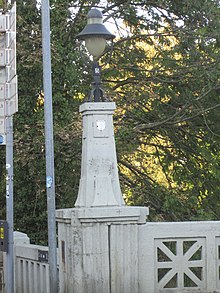
In the urban area of Bünde there are a large number of bridges that cross the River Else . The oldest detectable bridge is the Bolldammbrücke, which has been documented since the 13th century. The name goes back to the Bolldamm (today's Bahnhofstrasse), which was initially a path through the Elseaue, which at that time still extended to today's Strasse Wasserbreite. The bridge structure visible today dates from the 1920s and was created in the course of the Elseregulierung (i.e. the straightening of the river). Another historically documented bridge is the so-called Eschenbrücke, over which the Lübbecker Straße leads today. A river crossing had existed at this point since the 15th century, which was subject to a bridge toll since the 18th century. Today's modern bridge dates from 1957. The other bridges in the Bünder urban area are more recent. The Bismarck Bridge goes back to a forerunner from 1915, which, however, was never opened to traffic due to construction defects. The building, which is still in use today, was inaugurated in 1934. Another modern bridge structure is the Theodor-Heuss-Brücke between the tax office and the town hall. This bridge initially existed as a wooden footbridge, but was replaced by a concrete structure in 1976
Rail and bus transport
The Bünde station is on the Löhne – Rheine railway line , from which the Ravensberger Bahn branches off to Rahden . It is served by IC trains on the Schiphol Airport - Osnabrück - Hanover - Berlin line. In local traffic, RE and RB trains in the direction of Herford - Bielefeld , Minden - Hanover - Braunschweig , Osnabrück - Rheine - Bad Bentheim , Lübbecke - Rahden and Hameln - Hildesheim stop . The lines are operated by DB Regio Nord , Westfalenbahn and Eurobahn .
There was also a train station on the Löhne – Rheine railway in the Ahle district and on the Bassum – Herford railway in the Holsen district.
The city has a city bus system with four lines. As a bus meeting point for the rendezvous system, a central bus station was built on Museumsplatz in the immediate vicinity of the pedestrian zone. There is also an information office with ticket sales. The operator of the city buses is the Omnibus-Verkehrs-Gesellschaft Bollmeyer mbH & Co. KG . The districts Ahle , Holsen and Muckum are not connected to the city bus network.
The station is an important second transfer point in the city and is served by city bus line 2. The regional bus routes to Herford (line 646) and Enger (line 654) start at the central bus station next to the train station . Other buses or dial-a-bus services serve Hüllhorst (line 542), Kirchlengern (lines 541, 542, 544, 545, 558 and 559), Spenge (line 572) and Rödinghausen (lines 542, 543 and 571). The regional buses usually also stop at the market square, where you can also change to the city buses.
The city is part of the Westfalentarif tariff association ( TeutoOWL network ). Association tickets are not valid to Melle, Bissendorf and in the night buses to Herford and Bielefeld.
Bicycle traffic
The city of Bünde is a member of the working group for bicycle-friendly cities and municipalities in North Rhine-Westphalia and a member of the ADFC . Through the urban area runs u. a. the Else-Werre-Radweg (54.5 km from the bifurcation to the mouth of the Werre in Bad Oeynhausen ) and the BahnRadRoute Weser-Lippe (350 km from Bremen to Paderborn ). Bünde has an electronically controlled bicycle parking facility at the train station and in 2007 was awarded the title of “bicycle-friendly city”.
The cycling network connects all of Graubünden's districts and the surrounding communities via its 13 lines. Rings of 10, 20 and 35 km in length create a cobweb-like link. The middle of the network and at the same time the intersection of all cycle routes is located in the city center at the Bolldammbrücke, crossing Elsedamm / Frühlingsweg / Bahnhofstraße. The entire 120 km long cycle network is completely signposted. The display of the lines in red and the rings in green also makes orientation easier. The concept achieved 4th place in the nationwide bicycle climate test of the General German Bicycle Club (ADFC) in cities with less than 100,000 inhabitants. In 2012 the 7th place was achieved here.
Numerous campaigns such as the Bünder Radelsommer, Volksradfahren “1000 Fahrrad Bünde”, the campaign “By bike to work” and night cycling promote the use of bicycles.
media
The daily newspapers, each with a local section for Bünde, are the Neue Westfälische and the Westfalen-Blatt . The local radio station, Radio Herford, can be received in the city on 94.9 MHz.
Other free newspapers in Bünde (not published daily) are u. a .:
- Life - the city magazine
- Covenant citizen
- OWL on Wednesday
- OWL on Sunday
- Talk of the town
Established businesses
The nickname “ cigar city” reminds us that at the turn of the 19th and 20th centuries, more than 20 cigar factories were still based in Bünde and that a large part of the cigars sold in Germany came here. From the heyday of the tobacco industry, the traditional companies Arnold André (main brand: Clubmaster, 450 employees) and August Schuster remained in the city. The company Villiger Söhne Holding has a branch here. Kitchen furniture manufacturers are traditionally well represented. This is partly due to the fact that after the decline of the tobacco industry, the know-how of making cigar boxes flowed into the production of furniture.
The largest employer in Bünde is now the kitchen appliance manufacturer Miele , formerly Imperial (760 employees). The well-known model kit manufacturer Revell is also located with its only German location in Bünde. In addition, the special glass manufacturer Gerresheimer -Bünde GmbH (formerly Bünder Glas , with more than 500 employees) and one of the oldest civil engineering companies in the region, Westerhold Tiefbau GmbH , have their headquarters in Bünde.
tourism
The state-approved resort town of Randringhausen in the northeast of the city has served as a spa area since the 18th century . A spa house for mud, sulfur and exercise baths is available to guests. Randringhausen continues the centuries-old bathing tradition in Bünde, as the first healthy fountain was discovered in the town in 1728. The name Bäderstraße is a reminder of the time when Bad Bünde and its baths were still there. The densely wooded recreation area Randringhausen covers around 266 hectares and includes the actual spa area with around 34 hectares.
Personalities
Honorary citizen
- Friedrich Langewiesche , * 1867; † 1958, worked in Bünde as a teacher, researcher and fossil collector since 1896. He researched u. a. the Doberg. He donated his first exhibits to the Doberg Museum and thus founded it. Langewiesche became the first honorary citizen of the city of Bünde in 1953.
- Richard Moes , * 1887; † 1968, mayor of Bünder 1925–1937, appointed honorary citizen in 1962.
- Theophylaktos Emmanouilidis, former head physician of the Lukas Hospital and chairman of the Hammer Forum , appointed honorary citizen in 2019.
Daughters and sons of the city
The following personalities were born in Bünde:
- 1777: August Ernst Rauschenbusch , educator and Lutheran clergyman
- 1821: Tönnies Wellensiek , founder of the city's cigar industry
- 1825: Salomon Blumenau , Prussian educator and preacher
- 1860: Otto von Steinmeister , district president in Cologne
- 1898: Walter Diekmann , politician and Lord Mayor of Oldenburg
- 1899: Gustav Galle , District President of Detmold
- 1900: Wilhelm Husmann , chemist
- 1901: Rudolf Bäumer , politician (SPD), member of the German Bundestag
- 1901: Wilhelm Dopheide , pulmonologist and during the Second World War head of the health department in the Galicia district of the Generalgouvernement
- 1903: Heinrich Kemner , theologian
- 1907: Hermann Wohlgethan , presiding judge in the GDR
- 1907: Hans Rosenwald , musicologist
- 1908: Walter Bäumer , racing driver
- 1914: Heinrich Klaustermeyer , police officer and SS-Oberscharführer
- 1920: Siegfried Moning , District Administrator
- 1924: Hellmuth Buddenberg , CEO of Deutsche BP
- 1931: Friedrich Rakob , architect and archaeologist at the German Archaeological Institute in Rome
- 1933: Karlfried Stuke , football player
- 1937: Brunhild Decking-Schwill , politician (CDU)
- 1942: Gunter Gabriel , singer and lyricist
- 1944: Klaus Beckmann , politician, Parliamentary State Secretary
- 1948: Eckart Pott , biologist, author and nature photographer
- 1949: Ulrich Horstmann , literary scholar and writer
- 1950: Dieter Becker , professor for mission theology and religious studies
- 1950: Volker Schiek , politician (SPD)
- 1951: Norbert Hähnel , singer
- 1951: Eckhard Lübkemeier , political scientist and diplomat
- 1952: Bernd Jürgen Fischer , American albanologist and historian
- 1953: Burkhard Budde , Protestant theologian, author, journalist and local politician
- 1953: Reinhard Göhner , politician, employer functionary
- 1953: Jürgen Klute , politician
- 1954: Peter Buchholz , actor, playwright, screenwriter and voice actor
- 1955: Erhard O. Müller , politician and political editor
- 1956: Stefan Blankertz , writer
- 1958: Elke Kruse , musician
- 1960: Michael Arlt , musician
- 1966: Johannes Seemüller , sports reporter
- 1969: Manuela Fersen , artist
- 1970: Christian Sewing , CEO of Deutsche Bank
- 1971: Lars Montag , director
- 1977: Jens Westerbeck , writer, television author and gag writer
- 1981: Aziz Bozkurt , politician, federal chairman of the AG Migration and Diversity in the SPD
- 1983: Tobias Duffner , soccer goalkeeper
- 1983: Aylin Tezel , actress and dancer
- 1984: David Odonkor , football player
- 1986: Marie Lang , Kickboxing - World Champion
- 1996: Pascal Stenzel , soccer player
Other personalities
The following personalities do not come from Bünde, but have worked in the city or are still active:
- Hengest and Horsa , according to legend, these two Saxon tribal leaders and brothers (whose historicity is very controversial) forged the alliance for the conquest of England in Bünde
- Otto von Arnim (1785–1820), lawyer, judge in Bünde
- August Steinmeister (1820–1874), cigar manufacturer, partner in the Steinmeister & Wellensiek cigar factory
- Georg von Detten (1837–1919), lawyer, judge in Bünde
- Gustav von Bodelschwingh (1872–1944), theologian, pastor in Ennigloh and Ahle
- Karl Koch (1876–1951), theologian, pastor in Ennigloh
- Siegfried von Campe (1885–1972), lawyer, trainee lawyer in Bünde
- Hermann Busse (1903–1970), politician, student in Bünde
- Karl Paetow (1903–1992), folklorist, director of the tobacco museum
- Erhard Gorys (1926-2004), writer, lived in Bünde
- Hans Werner Henze (1926–2012), composer, spent several years of his childhood in the Bünder district of Dünne from 1933 onwards
- Fritz Pleitgen (* 1938), journalist, attended the Freiherr-vom-Stein-Gymnasium here from time to time and during this time worked as a sports reporter for the Free Press at the time ; Honorary high school graduate of the grammar school on the market
- Hubert Berenbrinker (* 1950), auxiliary bishop, vicar in Holsen
- Matthias König (* 1959), bishop, pastor in Holsen
- CC Catch (* 1964) (bourgeois: Caroline Catharina Müller), musician, lived in Bünde for a few years and attended secondary school there
- Christoph Dammermann (* 1967), politician (FDP), former 1st deputy mayor of the city
- Frank Schäffler (* 1968), politician (FDP), member of the German Bundestag, lives in Bünde
- Chris Bollenbach (* 1972), politician, grew up in Bünde
- Maike Tatzig (* 1973), TV producer (including Schillerstraße ), received the German television and Comedy Prize 2005, grew up in Bünde
- Maximilian Hecker (* 1977), musician, lived in Bünde for many years and graduated from Freiherr-vom-Stein-Gymnasium
- Andreas Ehrlich (* 1978), show magician with the Ehrlich Brothers duo , lives in Bünde
literature
- Gertrud Angermann: The documentary tradition of the oldest history of the place Bünde. In: Annual report of the Historical Association for the County of Ravensberg 59 (1956/57), pp. 128–140.
- Gabriele Isenberg: On the building history of the Protestant Laurentius Church in Bünde. A preliminary report on the excavations in 1979. In: Westfalen 61 (1983), pp. 42–49.
- Norbert Sahrhage: Economic and social conditions in the office of Bünde around the middle of the 19th century. In: Wittekindsland. Contributions to the history, culture and nature of the Herford district, vol. 3: America emigration from the offices of Bünde, Rödinghausen, Kirchlengern and Gohfeld-Mennighüffen in the 19th century, ed. v. Kreisheimatverein Herford, Löhne 1990, pp. 58-67.
- Norbert Sahrhage: “Jews are not wanted in this city!” The history of the synagogue community of Bünde in the “Third Reich”. Bielefeld: Publishing house for regional history 1988. ISBN 3-927085-09-X
- Norbert Sahrhage: Alliances between seizure of power and denazification. History of a small Westphalian town from 1929–1953 . Bielefeld: Verlag für Regionalgeschichte 1990. ISBN 3-927085-19-7
- Klaus Ackermann / Ingo Hecker (eds.): Bünde - Faces of a City . Herford: Maximilian Verlag 1992. ISBN 3-7869-0295-X
- Wolfgang Linke, Regional Association Westphalia-Lippe (Ed.): Bünde. From the series: Westfalen im Bild - a picture media collection on Westphalian regional studies . Landschaftsverband Westfalen-Lippe / Landesbildstelle Westfalen. 1994.
- Eberhard Pannkoke, Stadtarchiv Stadt Bünde (Hrsg.): Bünde - how it used to be. Gudensberg-Gleichen: Wartberg Verlag 1999. Without ISBN.
- Martin Fiedler; Monika Dickhaus; Norbert Sahrhage: traces of the cigar. Bünde - a tour through Germany's cigar box. Essen: Klartext-Verlagsgesellschaft 2000. ISBN 3-88474-903-X
- Wolfgang Heyer; Ulrich Müller; Friedhelm Tiemann: Times are changing . Münster: Daedalus 2003. ISBN 3-89126-205-1
- Eris Valentowicz: Bünde between 1900 and 1960. Erfurt: Sutton Verlag 2005. ISBN 3-89702-929-4
- Ingo Hecker / Jörg Militzer: Bünde - City in Transition . Bünde: Buginithi Verlag 2009. ISBN 978-3-00-029081-7
- Jörg Militzer: Greetings from Bünde . Bünde: Buginithi Verlag 2010. ISBN 978-3-9813973-0-7
- Ingo Hecker / Jörg Militzer: Bünde - City in Transition II . Bünde: Buginithi Verlag 2014. ISBN 978-3-9813973-1-4
Web links
- Website of the city of Bünde
- Website on the history of the city of Bünde
- Bünde in the Westphalia Culture Atlas
Individual evidence
- ↑ Population of the municipalities of North Rhine-Westphalia on December 31, 2019 - update of the population based on the census of May 9, 2011. State Office for Information and Technology North Rhine-Westphalia (IT.NRW), accessed on June 17, 2020 . ( Help on this )
- ↑ a b Population statistics for the city of Bünde. (PDF) buende.de, February 4, 2019, accessed on June 14, 2019 .
- ↑ Geological Service NRW: Using geothermal energy - Geothermal study provides planning basis ( Memento from September 14, 2005 in the Internet Archive ) (PDF; 369 kB)
- ↑ a b Municipal profile of Bünde, city. (PDF) it.nrw, April 24, 2019, accessed June 14, 2019 .
- ↑ Meteorological information ( Memento of February 18, 2008 in the Internet Archive ), html, State Office for Data Processing and Statistics, access date: July 2, 2007 (archive version)
- ↑ HF-Magazin (2006-2012) HF-Magazin No. 65, page 12. (PDF )kreisheimatverein.de, June 19, 2008, accessed on June 17, 2019 .
- ↑ Chronicle table 1850–1860 , html, Stadtarchiv Bünde, retrieval date: July 2007
- ↑ a b Bünde im National Socialism , HTML, history project of the Freiherr-vom-Stein-Gymnasium, accessed July 2007
- ↑ Martin Bünermann: The communities of the first reorganization program in North Rhine-Westphalia . Deutscher Gemeindeverlag, Cologne 1970, p. 73 .
- ↑ Website Widukind-Gymnasium Enger, retrieval date: July 1, 2007 (archive version) ( Memento of October 20, 2007 in the Internet Archive )
- ↑ Bünde im National Socialism , html, / Statistical Data / Population, History Project of the Freiherr-vom-Stein-Gymnasium, accessed July 2007
- ↑ a b Martin Bünermann, Heinz Köstering: The communities and districts after the local government reform in North Rhine-Westphalia . Deutscher Gemeindeverlag, Cologne 1975, ISBN 3-555-30092-X , p. 101 f .
- ↑ Municipal profile of Bünde ( Memento of the original of November 18, 2007 in the Internet Archive ) Info: The archive link was automatically inserted and not yet checked. Please check the original and archive link according to the instructions and then remove this notice. , PDF, State Office for Data Processing and Statistics, as of 2007
- ↑ Pupils at general education schools in North Rhine-Westphalia according to religious affiliation ( Memento from December 25, 2005 in the Internet Archive ), PDF, State Office for Data Processing and Statistics, as of 2002/03 (archive version)
- ↑ Norbert Sahrhage: “Jews are not wanted in this city!” The history of the synagogue community of Bünde in the “Third Reich”. Bielefeld 1988. p. 19.
- ↑ State database NRW
- ^ State Office for Information and Technology in North Rhine-Westphalia: Local elections
- ^ Regional Returning Officer North Rhine-Westphalia
- ↑ Bünde election results 2014
- ↑ Westfalen Blatt: Decision about mayor and district administrator: SPD wins four out of five runoff elections Issue of June 16, 2014, accessed on June 17, 2014
- ^ Certificate of approval from the District President in Detmold
- ↑ Home. Retrieved September 7, 2017 (UK English).
- ↑ http://kunstkarree.de/
- ↑ WESTFALEN-BLATT: Bünder outdoor swimming pool construction is making good progress. Retrieved on May 3, 2020 (German).
- ^ Regional Association Westphalia-Lippe: Steinmeisterpark in LWL-GeodatenKultur
- ^ Regional Association Westphalia-Lippe: Kurpark Randringhausen in LWL-GeodatenKultur
- ↑ a b c d Along the Else in Bünde / Herford district. Retrieved March 23, 2019 .
- ↑ Results of the ADFC Bicycle Climate Test 2012 ( Memento from February 3, 2013 in the Internet Archive )
- ↑ Honorary citizen of the city of Bünde: Dr. Theophylaktos Emmanouilidis. City of Bünde, July 22, 2019, accessed on December 3, 2019 .




